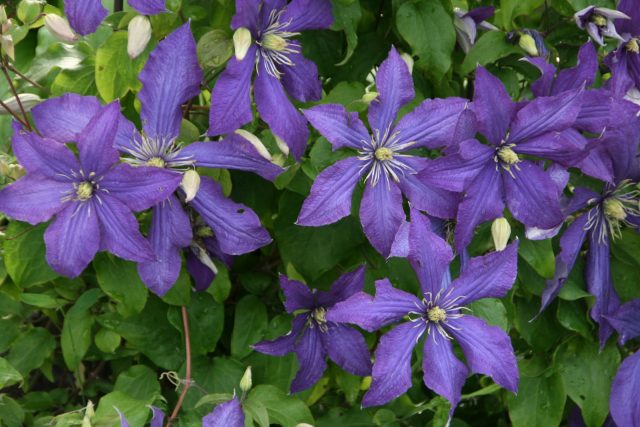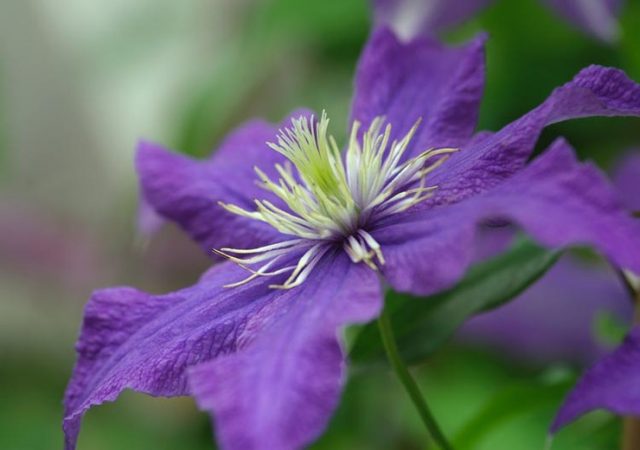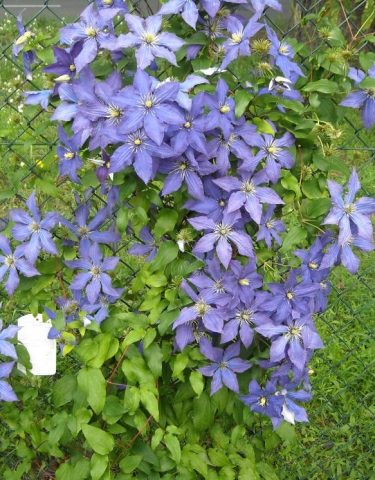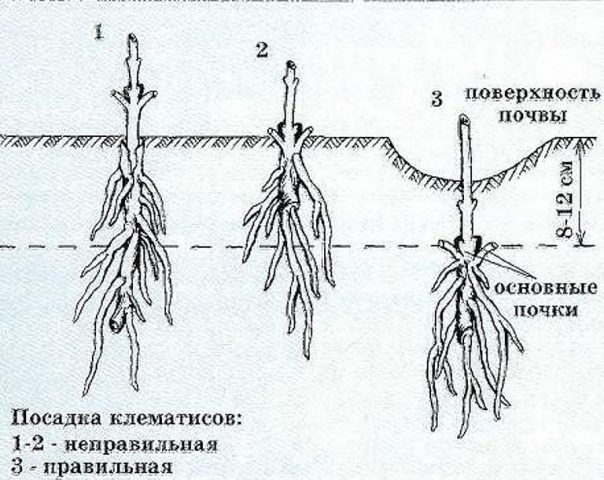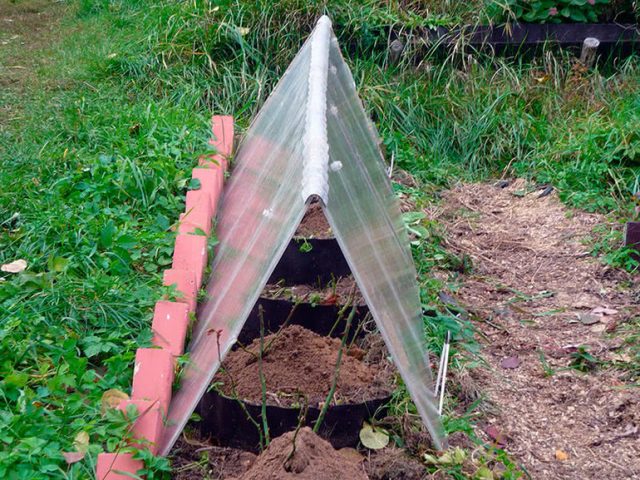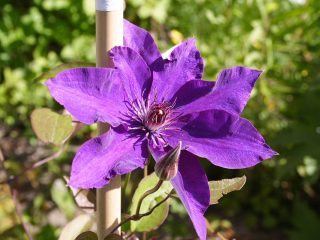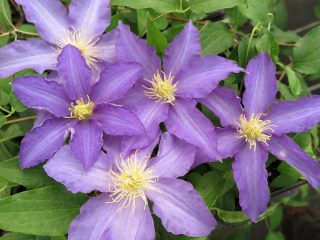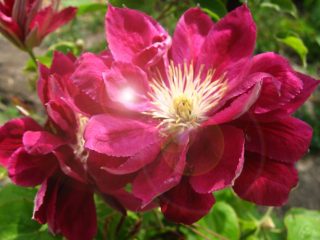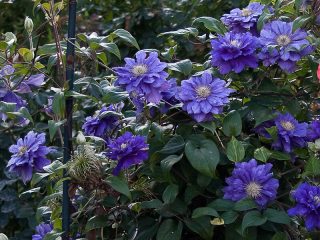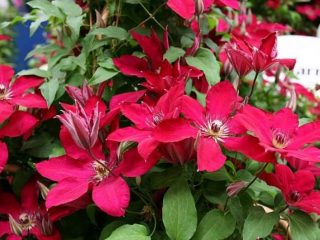Content
Clematis Rhapsody was bred by the English breeder F. Watkinson in 1988. Abundant flowering of a variety of the third pruning group is very effective. Curly large-flowered clematis is unpretentious, develops in any exposition.
Description of Clematis Rhapsody
The bush of the Rhapsody variety is compact, the vines rise almost vertically along the trellises, grow little to the sides, only up to 60-90 cm, the volume in diameter is also up to 90 cm.The root system is developed, spreading, densely fibrous. Stems are flexible, thin, strong, held on supports by tenacious green tendrils. The height of the clematis Rhapsody lashes is small - from 1.5 to 2.5 m, which depends on the fertility of the soil and growing conditions. The bright, soft shade, reddish-brown color of climbing stems stands out in contrast to the green leaves and the blue of the opened buds.
The dense leaf blades are opposite, on very short greenish petioles. The shape of the leaves is ovate-elongated, gradually sharpening towards the top. Oblong veins are clearly visible. The upper part of the clematis leaf is smooth, the purl is slightly rough to the touch, with protruding veins.
Whitish-green buds are formed on strong, long stems growing on shoots that formed in the spring. Abundant flowering begins at the bottom of the shoots and gradually spreads to the entire stem. In August, the very first shoots are cut, making room for new ones, on which buds appear over time for autumn flowering.
Single flowers are large, flat, up to 10-12 cm in diameter. Like all clematis, sepals, which take on the role of petals, are the most decorative part of the plant. The shape of the petals, the number of which is usually 6 pieces, is oval-elongated, pointed to the apex, 5 to 7 cm in size, 1.5-2.5 cm wide, the border is slightly wavy. From the center, the petals bend smoothly, forming a graceful, slightly convex arc. In the middle, 3 veins are pronounced.
The flowers of the Rhapsody variety have a blue-violet hue that changes visually depending on the lighting. The petals blooming in the sun are bright blue, with purple nuances, do not fade. In the shade, which clematis Rhapsody easily tolerates, the opening buds of a more saturated tone, to dark purple. Numerous light yellow clematis stamens, which gardeners call "spider", visually illuminate the middle of the flower and draw attention to it.
Flowering is long, from the end of the second or middle of the third decade of June to the end of September. Florists note that Clematis Rhapsody blooms from 100 to 130 days. The life of one flower is also long-lasting.
Clematis trimming group Rhapsody
It is believed that the large-flowered clematis variety Rhapsody belongs to the 3rd pruning group. Plants are strongly pruned before wintering, leaving 20-30 cm of the stem. In the spring, the bush creates new shoots on which flowers form.
Growing conditions for clematis Rhapsody
The climbing large-flowered plant is sun-loving, so it is better to place the clematis bush in the following positions:
- on the south side of the building or fence;
- in the southeast direction;
- facing southwest.
In the southern regions, this clematis will grow well from the north of a low fence or structure. The variety tolerates partial shade. Therefore, they can decorate the trunk of a tall tree with a thin crown through which sunlight is sifted.
According to the photo and description of clematis Rhapsody, a plant of moderate height, winds along an arch or a gazebo. For the bush, they provide shading from the sun, planting low, leafy annuals or perennials in the trunk circle. Clematis roots feed in the depths of the soil, so herbaceous ground covers do not represent competition for them. The Rhapsody variety is winter-hardy, tolerates short-term frosts up to -34 ° C. If a flowering plant is planted in a harsh climate, for the winter, the hemp after cutting the stems is covered with a thick layer of mulch.
The clematis Rhapsody variety, which is characterized by moderate growth and abundant long flowering, is often grown as a container crop on the terraces of country houses or on the balconies of city high-rise buildings. The volume of the tub is not less than 10-15 liters. Such a planting of clematis requires mandatory regular fertilizing with complex fertilizers.
Planting and caring for hybrid clematis Rhapsody
When growing a non-capricious variety, it is important to follow the recommendations according to the description and pruning group of clematis Rhapsody. Planting times differ by region:
- in the south they are planted from late September to November 7-10;
- in areas of the middle zone with a relatively mild climate - during September;
- in more severe areas - at the end of April, beginning of May.
Selection and preparation of the landing site
The undemanding clematis Rhapsody will grow everywhere, except in thick shade or in the southern regions - in the sun itself. For planting, a fertile area is prepared, where loose loams or sandy loams with an acid reaction close to neutral or slightly acidic - from 6.5 to 7 pH - prevail. The plant can stay in one place for more than 20 years, so a rather large hole with dimensions of 60x60x60 cm is carefully prepared:
- 1 part of the top layer of the earth is mixed with 1 part of humus or compost;
- on clay soils, add 1 part of sand for the looseness of the substrate;
- poor sandy soils are compacted with 2 parts of clay and humus.
Starter fertilizers are added to the prepared substrate:
- 200 g of a complex mineral preparation;
- 120 g superphosphate;
- 100 g bone meal;
- 200 g of wood ash.
On acidic soils, 200 g of slaked lime is added to the pit.
Seedling preparation
Choosing clematis, examine its roots - dense, fibrous, elastic, with fine hairs. The cut stems are also fresh to the touch, flexible, with swollen buds. Flowers are delivered to the planting site tightly wrapped in a wet cloth and soaked for 6-12 hours. Plants in containers are placed in a large container of water so that the roots can be easily removed along with the earthy clod.
Landing rules
For the successful development of the Rhapsody variety, they adhere to the recommendations:
- in areas with dense soil, a drainage layer is laid;
- half of the pit is filled with part of the substrate, forming the soil with a mound;
- put a seedling, straightening the roots so that the root collar is 8-11 cm below the surface level;
- the base of a solid support is installed next to it;
- lay the entire substrate, watered and mulched.
When planting in spring, the hole is not covered to the level of the garden soil, the plant forms a lush bush.In autumn, the hole is completely filled and mulched.
Watering and feeding
Clematis bushes Rhapsody are watered once a week, 10-20 liters for a plant, so that the earth is moistened to the entire depth of the root system. During periods of drought, water is often watered, trying not to direct the stream of water to the center of the bush. In April, all clematis is spilled with a solution of lime: 200 g of the substance are diluted in a bucket of water. Top dressing is carried out after watering 3-4 times per season:
- nitrogen - after the formation of shoots in the spring;
- potash - before laying the buds;
- organic - before flowering;
- phosphorus-potash - in August.
Mulching and loosening
Laying a layer of mulch will retain moisture and during drought will protect the hot weather-susceptible clematis roots, as will the planting of low herbaceous plants. If there is no mulch, the soil is loosened, weeds are removed.
Pruning
The stems of clematis Rhapsody are cut at the end of September, keeping 2-3 knots. The hole is mulched for the winter. Sometimes a few strong shoots are left, twisting on the ground and also covering with mulch.
Preparing for winter
When pruning clematis stems, remove all leaves. Humus and peat mixed with dry superphosphate and wood ash are poured into the hole. In harsh conditions, they additionally cover with burlap, spruce branches, or save a valuable variety of clematis Rhapsody, as in the photo, in a greenhouse.
Reproduction
The clematis Rhapsody variety is bred vegetatively:
- adult 5-8-year-old bushes are divided in autumn, late August, early September or early spring;
- 1-2 lashes are added in the spring for layering, dividing the seedlings no earlier than a year later;
- rooted by cuttings.
Diseases and pests
Often the clematis of the Rhapsody variety is affected by wilting. The causative agents of the disease are different fungi, from which they are protected, observing agricultural techniques:
- when watering the soil is not waterlogged;
- bushes are not overfed with nitrogen preparations;
- in spring and autumn, prophylaxis with foundation or copper sulfate is carried out.
Grayish and whitish blooms on the stems and leaves of clematis Rhapsody are a symptom of the development of gray rot or powdery mildew. When rusty, the leaves are covered with orange circles. For treatment, fungicides are used. Insecticides are used against leaf-eating insects.
Conclusion
Clematis Rhapsody is a variety that is in demand in vertical gardening, since the whips tend upward without taking up much horizontal space. Unpretentiousness and long flowering attract gardeners.
